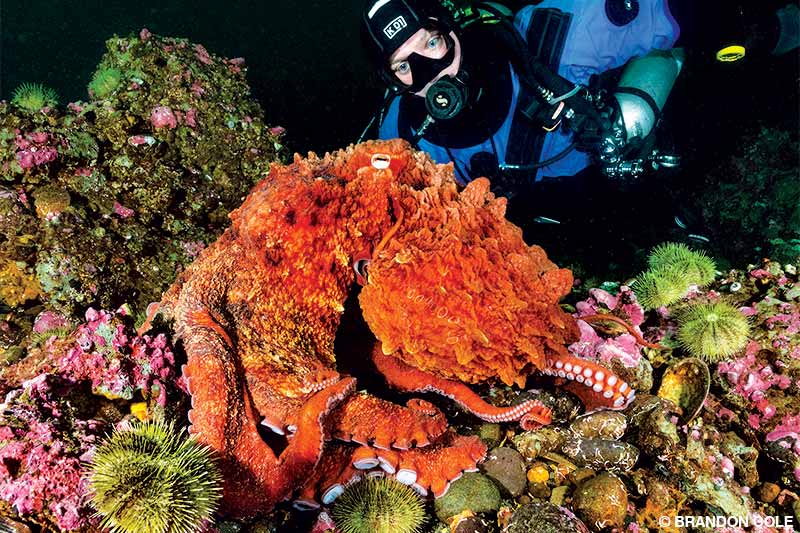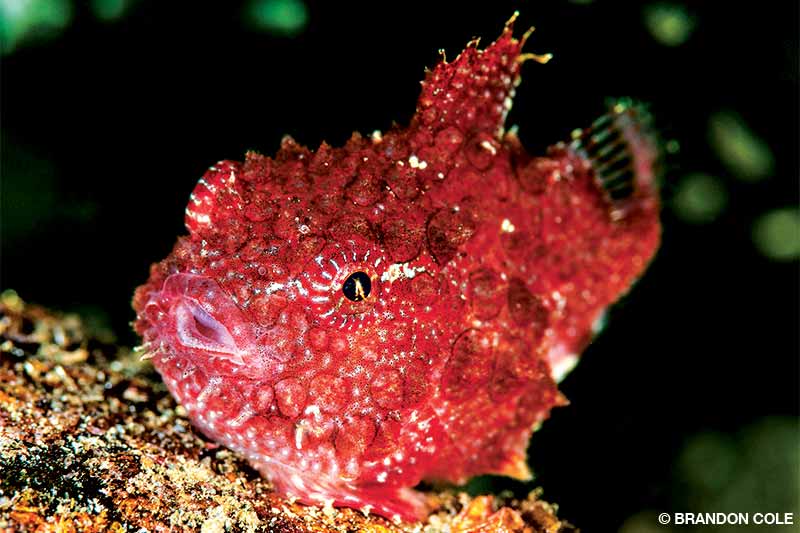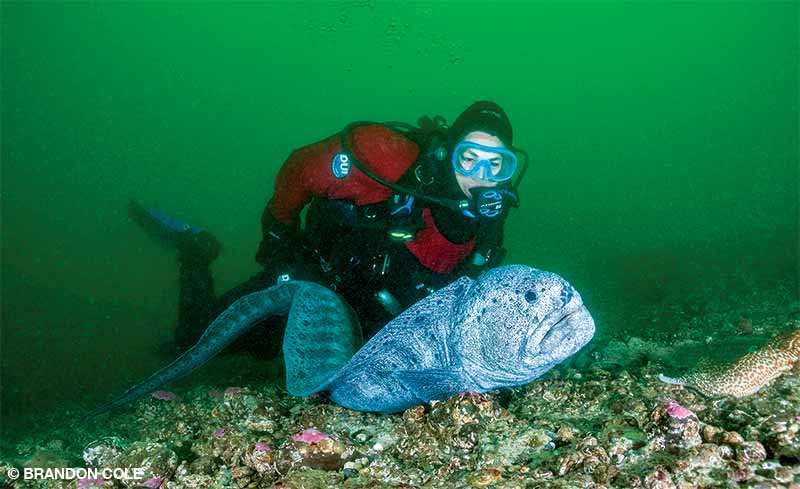Critter hunting in Washington’s Salish Sea
There’s a big difference between casual, submerged sightseeing — happy-snapping pictures of whatever you run across while blowing bubbles — and diving dedicated to carefully searching select sites, sometimes during a particular season or time of day, to find and photograph predefined species. It’s possible to luck out while wandering about, but success more often involves a plan.
The Salish Sea crosses the U.S.–Canada border, but its Washington portion encompasses Puget Sound, Hood Canal and the Strait of Juan de Fuca, which connects everything to the vast Pacific Ocean. It is also my local diving headquarters. The cool, plankton-rich waters hold a wealth of critters that underwater image-makers consider high-value targets. When something’s hot, it pays to devote bottom time to marine life currently basking in the limelight.
Let’s survey an eclectic mix of five portfolio-worthy photo subjects beneath the waves of the Evergreen State. Along the way, I’ll drop hints on where, when and how to prosper in this living treasure scavenger hunt.
Giant Pacific Octopus
Some years are better than others for critter hunting. Animal populations boom and bust, and ocean conditions vary widely. The winter of 2020–2021 was excellent for giant Pacific octopus (Enteroctopus dofleini).
I observed them out of their dens at Sunrise Beach Park, Day Island Wall and many spots in Hood Canal. The number of female octopuses brooding eggs made it extra special. To have a surplus of them at the same time on the same reef, tenderly caring for their offspring and valiantly guarding them against predators, was extraordinary. I executed six dives to document the mothers cleaning their eggs with tentacle caresses and oxygenating them with jets of water from their siphons.

Flagpole, Octopus Hole and Sund Rock in Hood Canal proved to be octopus gold mines. Having a slate to map den locations and note information was helpful, as were the generous local divers who shared their sightings.
Bluntnose Sixgill Sharks
Hexanchus griseus favors very deep water, but you can encounter this prehistoric shark (modern shark species have five gill slits) at a few venues in the Salish Sea. Encouraged by social media reports of recent sightings, I prepped my gear and drove 300 miles from my landlocked home in eastern Washington to Puget Sound.
It took three long decompression dives over three nights until a 7-foot adolescent bluntnose sixgill shark materialized from the blackness 95 feet down and southwest of the “deep line” at Redondo Beach. The creature transfixed me — utterly alien, graceful and ponderous at the same time. I stared in amazement through my camera into its metallic eyes. Three more sharks made brief appearances on that dive. It had been years since I had last seen a sixgill, and here I was in the presence of multiple.
The sharks’ seasonal appearance here in July and August may relate to salmon fishing and crabbing in the area. Divers have also seen sixgills at Rosie’s Ravine in Hood Canal.
Pacific Spiny Lumpsuckers
Never underestimate the excitement that weird little fish can generate. During winter, a hard-core subset of Seattle- and Tacoma-area divers schedules regular nighttime shore dives that feature the bug-eyed, pouty-lipped Pacific spiny lumpsucker (Eumicrotremus orbis). Ranging from pea-sized to as big as a jumbo tater tot, they are covered with conical protuberances — the lumps — instead of scales and have a suction-cup disc — the sucker — on their undersides to stick to algae and rocks. Their colors range from yellow to green, brown or red.

Finding lumpsuckers can be difficult due to their size, camouflage coloration and the wide-bladed kelp and tufts of algae in which they lurk, but practice helps you develop a knack for spotting them. In the words of one regular eagle-eyed shooter, Redondo Beach in central Puget Sound is “primo lumpy land.” She kindly taught me to get low and go slow while exploring the sandy slope south of the boat ramp. The sweet spot is between 10 and 15 feet deep, and winter delivers the most sightings and larger fish. Three Tree Point is another smart choice for a lumpsucker quest.
Wolf Eels
Wolf eels share local celebrity status with the eight-armed invertebrates mentioned above. It’s not uncommon to encounter both animals on the same dive while exploring rocky reefs and walls at many locales in Washington. Wolfies have a panache that more than compensates for their shortcomings in the beauty department. Like frogfish in the tropics, wolf eels entice me to photograph them even when not on my agenda.
I have a handful of go-to sites for dedicated eel searches. Skyline, south of Anacortes, is typically home to strikingly orange juvenile wolf eels measuring 1 to 2 feet long. Look for them snaking about in the sea cucumbers and algae above 30 feet. I have also found little guys peeking out of holes in Keystone Jetty’s wooden pier pilings and coiled up inside old glass bottles at Redondo.

You’re almost guaranteed to spy numerous adult wolfies in the rock piles at Sunrise Beach Park, Flagpole and Sund Rock. During winter, you might spot females wrapped around a volleyball-sized clutch of pink eggs. My favorite spot for quality encounters with wolf eels is Day Island Wall, which you can reach by shore or boat. The ledges and walls between 40 and 100 feet accommodate many wolf eels. Be sure to go during slack tide, ideally on a small exchange of less than 3 knots, to avoid the strong currents in the Tacoma Narrows.
Rock Greenlings
The rock greenling (Hexagrammos lagocephalus) is another critter that, like the sixgill shark, appears more frequently on bucket lists than in logbooks. Few divers have seen one, even though the species is not rare. They are simply hard to find and live where most divers never explore. They prefer shallow, rocky habitats battered by waves and surge and overgrown with thick, mixed kelp, eelgrass and algae. Their colors and patterns help them blend masterfully with the surroundings. Some rock greenlings may reside in the same area for years, which is one of the few advantages searchers have. The Strait of Juan de Fuca, specifically Salt Creek Recreation Area and Sekiu Jetty, have resident greenlings just waiting to be discovered in only 5 to 15 feet of water.

Even if you don’t see one, you’re sure to enjoy the abundant and diverse marine life on these stellar Washington shore dives. Monitor weather forecasts for calm conditions, and be prepared for a serious search once submerged. It took me two two-hour dives to find a greenling last year. Marking its location with a small surface marker buoy allowed me to easily return with my third tank to the exact spot in the bewildering maze of algae-covered rocks to photograph this spectacular fish in earnest. All the shivering, hard work and planning to reach this moment faded away.

How to Dive It
Conditions: Washington is a year-round diving destination. Puget Sound’s inland waters are sheltered from the Pacific Ocean’s storms and swell, while the Strait of Juan de Fuca is more exposed. Strong winds can develop throughout the region. Currents can be nonexistent to strong, depending on location and time of year. Some sites can be dived almost any time, while others require slack on small exchanges for safety and comfort.
Water temperatures range from the low-40s°F at depth in winter to the mid-50s°F in late summer. Thermoclines and freshwater layers can be present, especially after heavy rains. Drysuits allow you to customize undergarment thickness to your thermal tolerance. Water clarity is best in late fall and winter, with visibility between 20 and 50 feet. In spring and summer, plankton reduces the visibility, but the water may be clear beneath a murky surface layer.
There are dive sites suitable for all skill levels and interests: deep walls, shallow bays, muck dives, rocky reefs, jetties, pier pilings, purpose-sunk artificial reefs, seamounts and pinnacles. Many dive sites are accessible from shore.
Support: Many full-service dive shops in the region offer gas fills, gear and training, and area dive clubs and informal groups meet up for fun dives. The local diving community is active, supportive and willing to introduce visiting divers to the Salish Sea. Boat charters and private guide services are available.
Explore More
See more of Brandon Cole’s Salish Sea images in this bonus photo gallery.
© Alert Diver — Q3/Q4 2021